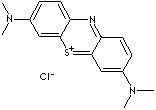PRODUCT IDENTIFICATION
7220-79-3 (Trihydrate)

c12c(nc3ccc(cc3[s+]1)N(C)C)ccc(N(C)C)c2.[ClH-]
CLASSIFICATION
EXTRA NOTES
EPA Pesticide Chemical Code 039505
water or alcohol have a deep blue color. Methylene blue is used as a bacteriologic stain and as an indicator. It inhibits Guanylate cyclase, and has been used to treat cyanide poisoning and to lower levels of Methemoglobin.
PHYSICAL AND CHEMICAL PROPERTIES
EXTERNAL LINKS & GENERAL DESCRIPTION
Wikipedia Linking - Methylene blue
Google Scholar Search - Methylene blue
Drug Information Portal (U.S. National Library of Medicine) - Methylene blue
PubChem Compound Summary - Methylene blue
KEGG (Kyoto Encyclopedia of Genes and Genomes) - Methylene blue
http://www.ebi.ac.uk/ - Methylene blue
http://www.ncbi.nlm.nih.gov/ - Methylene blue
http://toxnet.nlm.nih.gov/
Hazardous Substances Data Bank - Methylene blue
Local:
Methylene blue,
a methylated homologue of basic dye, is a cationic thiazine dye showing deep blue color in the
oxidized state. It is a highly hygroscopic dark green crystalline powder having a
bronze-like luster. It forms a reversible redox system with colorless
leukomethylene blue (the reduced state of methylene blue). They exist in
equilibrium. Methylene blue reduces the heme from methemoglobin to hemoglobin,
but methemoglobin is produced when equilibrium is destroyed at high level of
methylene blue. It is an electron donor or acceptor and free radical scavenger.
It is clinically used to identify anatomic and pathologic structures to treat
methemoglobinemia. It is used as a bacteriological in fresh frozen plasma. It is
used to treat ich. It is used as a pathological stain and as a diagnostic aid in
the detection of the premature rupture of fetal membranes and to identify
separate amniotic sacs in multiple pregnancies. It is used as a biological and bacteriological stain,
oxidation-reduction indicator as well.
APPEARANCE
DYE CONTENT
82.0% min
WATER
8 - 18.0%
SULFATED ASH
0.3% max
SOLUBILITY
430 (g/l in methanol)
HEAVY METALS
5ppm max
HAZARD OVERVIEW
Harmful if swallowed. Target Organ Effect, Harmful by ingestion., Irritant. Target Organs:Blood, Central nervous system, Eyes
GHS
PICTOGRAMS

HAZARD STATEMENTS
H302-H315-H319-H335
P STATEMENTS
P261-P305 + P351 + P338
![]()
RISK PHRASES
22-36/37/38
SAFETY PHRASES
26-36